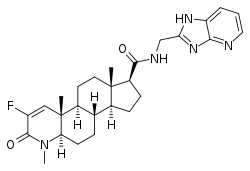MK-0773
MK-0773, also known as PF-05314882, is a steroidal, orally active selective androgen receptor modulator (SARM) that was under development by Merck and GTx for the treatment of sarcopenia (loss of muscle mass) in women and men.[1][2][3] Clinical trials for sarcopenia began in late 2007 but the collaboration between Merck and GTx ended in early 2010 and GTx terminated development of MK-0773 shortly thereafter.[2]
 | |
| Clinical data | |
|---|---|
| Other names | PF-05314882; N-(3H-Imidazo(4,5-b)pyridin-2-ylmethyl)-2-fluoro-4-methyl-3-oxo-4-aza-5α-androst-1-ene-17β-carboxamide |
| Routes of administration | By mouth |
| Identifiers | |
IUPAC name
| |
| CAS Number | |
| PubChem CID | |
| ChemSpider | |
| UNII | |
| Chemical and physical data | |
| Formula | C27H34FN5O2 |
| Molar mass | 479.600 g·mol−1 |
| 3D model (JSmol) | |
SMILES
| |
InChI
| |
MK-0773 is a 4-azasteroid[4] and a potent and selective agonist of the androgen receptor (AR).[1] It binds to the AR with an IC50 of 6.6 nM and is a partial agonist in transactivation modulation of the AR with an IP of 25 nM and Emax of 78% and has a TRAF2 Emax of 29% and a virilization (N/C interaction) counterscreen assay Emax of 2%.[1] That is, it produces promoter activation but induces the N/C interaction almost negligibly.[1] MK-0773 is reportedly four times as potent as testosterone as an agonist of the AR.[2] The drug is selective and does not bind to other steroid hormone receptors such as the progesterone receptor or glucocorticoid receptor and shows no significant inhibition of 5α-reductase (IC50 > 10 μM).[1] In addition, it is non-aromatizable and hence has no potential for estrogenic effects or side effects, like gynecomastia.[5] MK-0773 had similar effects on lipid metabolism relative to DHT, including a decrease in total cholesterol and high-density lipoprotein (HDL) of a similar magnitude.[1]
MK-0773 shows tissue-selective androgenic effects in vivo in animals.[1] It increases lean body mass with maximal anabolic effects that are approximately 80% of those of dihydrotestosterone (DHT).[1] However, it had less than 5% of the effect of DHT on uterine weight, about 30 to 50% of the increase of sebaceous gland area induced by DHT, and increased the weight of the seminal vesicles by 12% of that of DHT at the highest dosage assessed.[1] It had similarly reduced effects on the prostate gland.[1] No significant increase in gene expression of six candidate genes of virilization was observed.[6] As such, MK-0773 shows a profile of an anabolic SARM with limited effects on sebaceous glands and reproductive tissues in animals and a minimal propensity for virilization.[1]
In human clinical studies, MK-0773 produced anabolism in women and men while producing no or very low effects on sebaceous glands, the endometrium, or the prostate gland after 12 weeks of treatment.[1][6] A decrease in total cholesterol and HDL was also observed in the clinical studies.[1] MK-0773 produced a significant increase in lean body mass in elderly (≥65 years of age) women with sarcopenia and moderate physical dysfunction.[7][8][9] It also increased muscle strength relative to placebo but this failed to reach statistical significance.[7][9] MK-0773 has been associated with elevated liver enzymes in clinical studies.[7]
References
- Schmidt A, Kimmel DB, Bai C, Scafonas A, Rutledge S, Vogel RL, McElwee-Witmer S, Chen F, Nantermet PV, Kasparcova V, Leu CT, Zhang HZ, Duggan ME, Gentile MA, Hodor P, Pennypacker B, Masarachia P, Opas EE, Adamski SA, Cusick TE, Wang J, Mitchell HJ, Kim Y, Prueksaritanont T, Perkins JJ, Meissner RS, Hartman GD, Freedman LP, Harada S, Ray WJ (2010). "Discovery of the selective androgen receptor modulator MK-0773 using a rational development strategy based on differential transcriptional requirements for androgenic anabolism versus reproductive physiology". J. Biol. Chem. 285 (22): 17054–64. doi:10.1074/jbc.M109.099002. PMC 2878020. PMID 20356837.
- David E. Newton Ph.D. (26 November 2013). Steroids and Doping in Sports: A Reference Handbook: A Reference Handbook. ABC-CLIO. pp. 85–. ISBN 978-1-61069-314-1.
- http://webcache.googleusercontent.com/search?q=cache:kMshfiI-UnAJ:adisinsight.springer.com/drugs/800024550+&cd=1&hl=en&ct=clnk&gl=us
- Lagojda, Andreas; Kuehne, Dirk; Krug, Oliver; Thomas, Andreas; Wigger, Tina; Karst, Uwe; Schänzer, Wilhelm; Thevis, Mario (2016). "Identification of selected in vitro generated phase-I metabolites of the steroidal selective androgen receptor modulator MK-0773 for doping control purposes". European Journal of Mass Spectrometry. 22 (2): 49–59. doi:10.1255/ejms.1415. ISSN 1356-1049. PMID 27419898.
- Stoch, SA; Friedman, EJ; Zhou, Y; Zhu, H; Larson, P; Binkowitz, B; Chodakewitz, J; Wagner, JA (2010). "Biomarkers of Bone Metabolism and Serum Free Estradiol (E2) Levels in Medically Castrated Older Men Treated with MK-0773 (MK), Testosterone (T), or Placebo (PBO) for 12 Weeks": OR08–5–OR08–5. doi:10.1210/endo-meetings.2010.PART1.OR.OR08-5. Cite journal requires
|journal=(help) - Bruce H. Littman; Rajesh Krishna (31 January 2011). Translational Medicine and Drug Discovery. Cambridge University Press. pp. 136–. ISBN 978-1-139-49872-2.
- Papanicolaou, Dimitris A.; Ather, S. N.; Zhu, H.; Zhou, Y.; Lutkiewicz, J.; Scott, B. B.; Chandler, J. (2013). "A phase IIA randomized, placebo-controlled clinical trial to study the efficacy and safety of the selective androgen receptor modulator (SARM), MK-0773 in female participants with sarcopenia". The Journal of Nutrition, Health & Aging. 17 (6): 533–543. doi:10.1007/s12603-013-0335-x. ISSN 1279-7707. PMID 23732550.
- Chad Cox (24 February 2016). Clinical Nutrition and Aging: Sarcopenia and Muscle Metabolism. Apple Academic Press. pp. 258–. ISBN 978-1-77188-371-9.
- Jimmie C. Holland; William S. Breitbart; Paul B. Jacobsen; Phyllis N. Butow; Matthew J. Loscalzo; Ruth McCorkle (23 April 2015). Psycho-Oncology. Oxford University Press. pp. 242–. ISBN 978-0-19-936331-5.